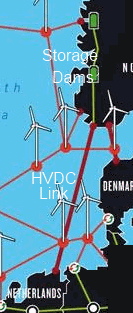|
|
|
|
|
|
|
News & Views item - December 2010 |
![]() Baseload
Power and a Supergrid. (December 4, 2010)
Baseload
Power and a Supergrid. (December 4, 2010)
 Two
recent articles, one by David Miles for
ABC Science and the other a feature by Colin Macilwain in
this week's
Nature address the matter of renewable energy supply
through solar and wind and the problem of baseload electricity requirements.
Two
recent articles, one by David Miles for
ABC Science and the other a feature by Colin Macilwain in
this week's
Nature address the matter of renewable energy supply
through solar and wind and the problem of baseload electricity requirements.
Mr Miles makes the observations that: "The wind is mostly uncontrolled (the only thing you can do is turn the wind generator on or off) and the concentrating solar thermal plants are equipped with low cost thermal (heat) storage like the plants recently installed in Spain, which can follow the grid load. The solar output rises and falls to balance the total output with the grid demand and takes the place of both intermediate peaking and fast peaking. The essential load-matching function is performed by the solar thermal storage [our emphasis].
However, Colin Macilwain notes that: "Wind energy is already a mainstay of clean power generation in Europe, with 74 gigawatts of capacity installed so far, and another 136GW anticipated by 2020, according to projections released by the European Commission (EC) in August... the large-scale storage of electricity so far developed for that purpose [is] pumped-storage hydroelectric dams, mostly located in Norway. Wind and other renewable energy sources are intermittent, but by using the energy to pump water uphill and recapturing power as the water flows down again, these dams can store electricity at more than 85% efficiency, evening out fluctuations in supply. The attractiveness of such storage helped to spur the completion in 2009 of a 'point-to-point' high-voltage direct-current (HVDC) link between Norway and the Netherlands, which allows surplus power from the low-lying Netherlands to be stored in the Norwegian fjords, and brought back when needed."
The use of a high-voltage direct-current link is because Alternating Current via underground or subsea transmission over more than about 80 kilometres (50 miles) suffers severe losses because the capacitance between cable and the surrounding earth drains the power from the a.c. line. From an Australian viewpoint, where the only requirement for long-distance underground or subsea transmission would be between the mainland and Tasmania, the requirement for advanced HVDC technology would be minimal.